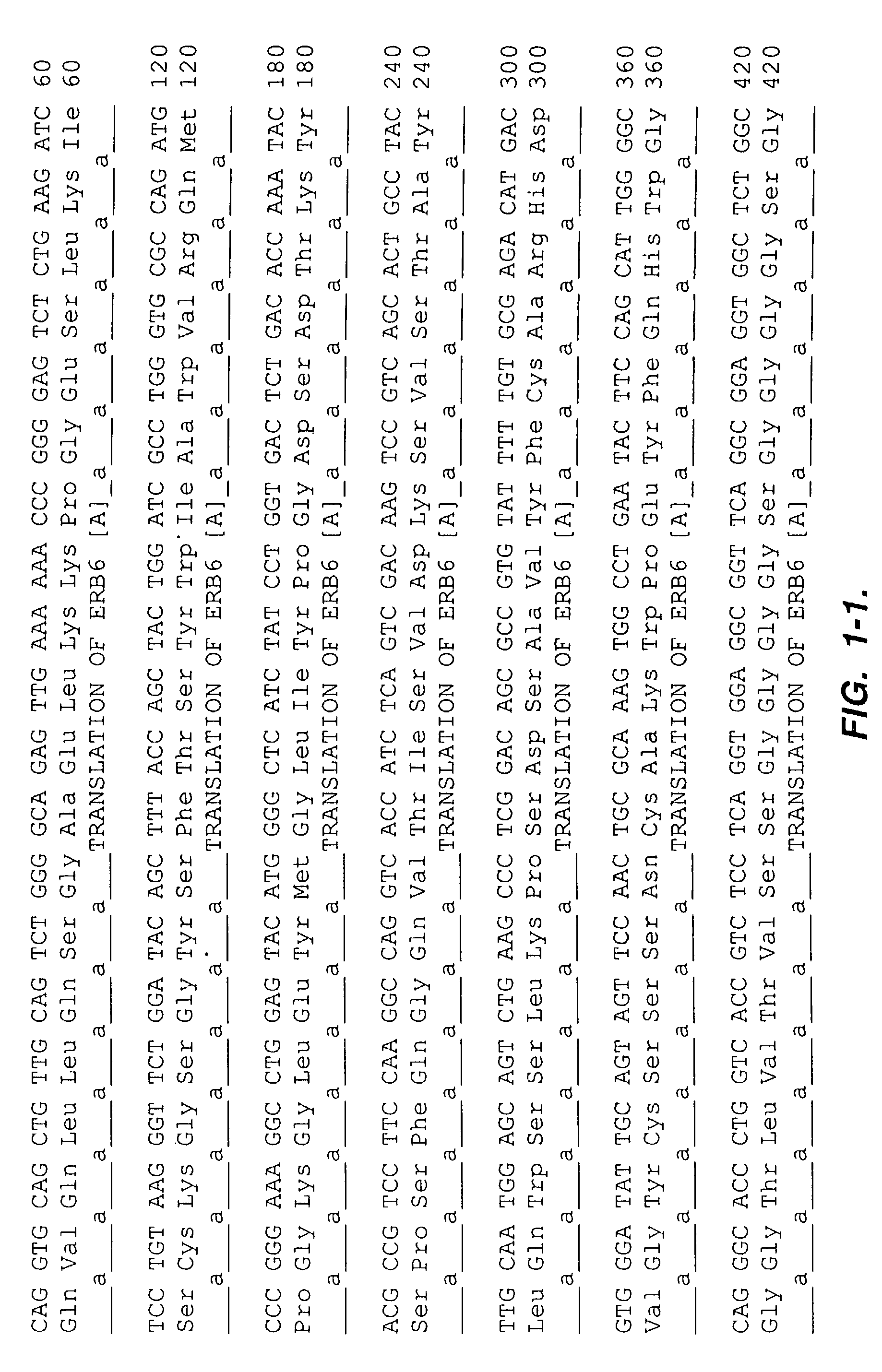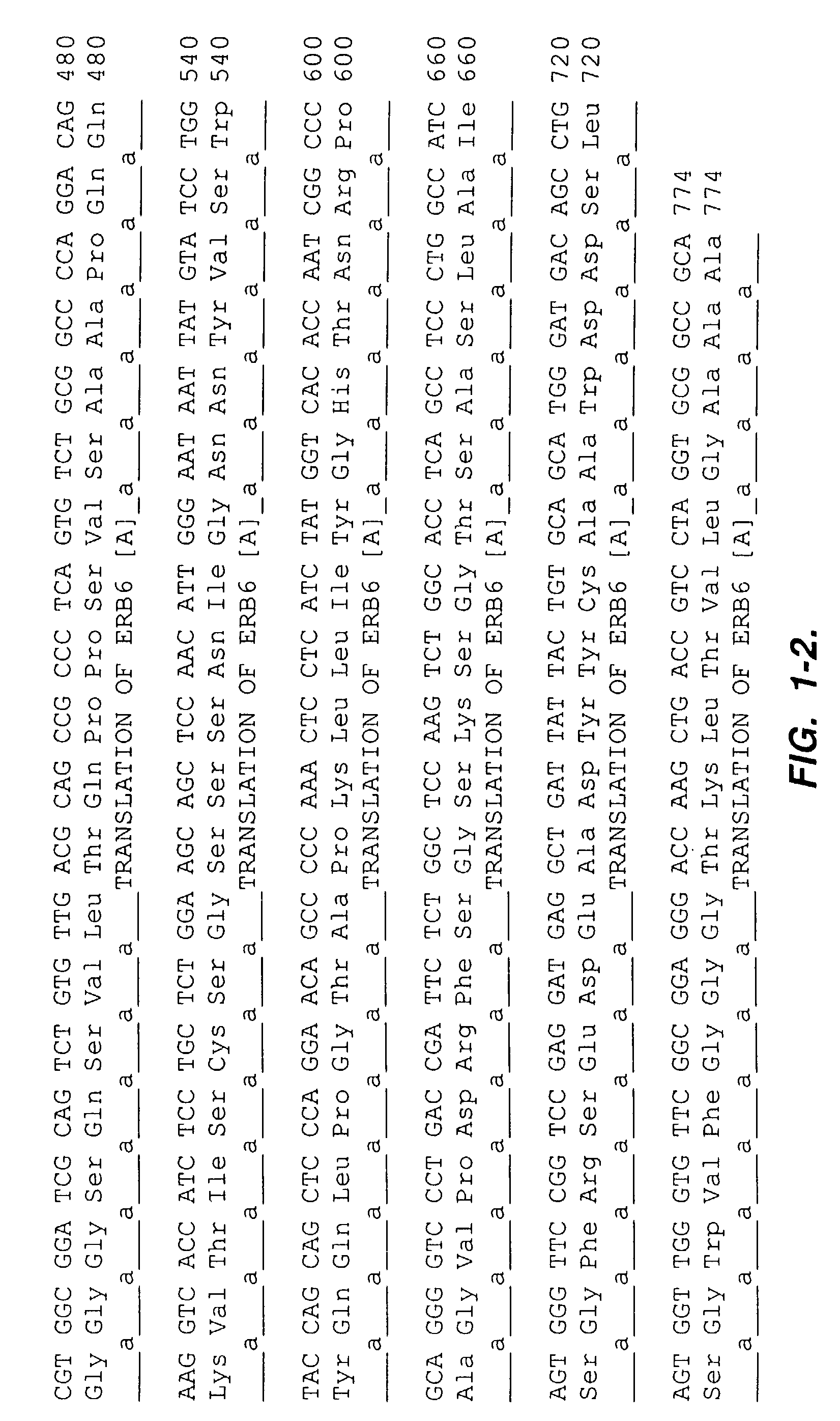High affinity human antibodies to tumor antigens
a human antibody and tumor technology, applied in the field of immunotherapy, can solve the problems of limited human immunotoxins use, damage and kill normal proliferating tissues, and the inability of conventional cancer chemotherapeutic agents to distinguish between normal cells and tumor cells, and achieve the effect of enhancing solubility
- Summary
- Abstract
- Description
- Claims
- Application Information
AI Technical Summary
Benefits of technology
Problems solved by technology
Method used
Image
Examples
example 1
Isolation and Characterization of Human Single-chain Fvs Binding C-erbb-2
Materials and Methods
Preparation of c-erbB-2 ECD
[0197]The antigen c-erbB-2 ECD with a Ser-Gly-His6 C-terminal fusion was expressed from Chinese Hamster Ovary cells and purified by immobilized metal affinity chromatography (IMAC).
Phage Preparation
[0198]Phage were prepared from a phagemid library (3×107 members) expressing sFv as pIII fusions on the phage surface (Marks et al. (1991) J. Mol. Biol. 222:581-597). The library was created from a repertoire of sFv genes consisting of human heavy and light chain variable region (VH and VL) genes isolated from the peripheral blood lymphocytes of unimmunized human volunteers. To rescue phagemid particles from the library, 50 ml of 2×TY media containing 100 μg / ml ampicillin and 1% glucose were inoculated with 108 bacteria taken from the frozen library glycerol stock. The culture was grown at 37° C. with shaking to an A600 nm of 0.8, 7.0×1011 colony forming units of VCS-M...
example 2
Isolation of High Affinity Monomeric Human Anti-cerb-2 Single Chain Fv Using Affinity Driven Selection
Materials and Methods
Construction of Heavy Chain Shuffled Libraries.
[0215]To facilitate heavy chain shuffling, libraries were constructed in pHEN-1 (Hoogenboom et al. (1991) Nucleic Acids Res. 19, 4133-4137) containing human VH gene repertoires (FR1 to FR3) and a cloning site at the end of VH FR3 for inserting the VH CDR3, VH FR4, linker DNA and light chain from binding sFv as a BssBII-NotI fragment. To create the libraries three VH gene repertoires enriched for human VH1, VH3, and VH5 gene were amplified by PCR using as a template single stranded DNA prepared from a 1.8×108 member sFv phage antibody library pHEN-1 (Marks et al. (1991) J. Mol. Biol. 222: 581-597). For PCR, 50 μl reactions were prepared containing 10 ng template, 25 pmol back primer (LMB3), 25 pmol forward primer (PVH1FOR1, PVH3FOR1, or PVH5FOR1), 250 uM-dNTPs, 1 mM MgCl2, and 0.5 μl (2 units) Taq DNA polymerase (Pro...
example 3
Production of Higher Affinity Mutants
[0247]In order to prepare higher affinity mutants derived from C6.5 part of the light chain and heavy chain CDR3 were sequentially randomized. The C6.5 VL CDR3 was modified by randomizing the sequence AAWDDSLSG (SEQ ID NO:60). The heavy chain CDR3 domain was randomized. The variable heavy chain CDR3 was randomized 4 amino acids at a time: In other words, the CDR3 sequence of HDVGYCSSSNCAKWPEYFQH (SEQ ID NO:61) was modified by randomizing SSSN (SEQ ID NO:62) (library B), DVGY (SEQ ID NO:63) (library A), AKPE (SEQ ID NO:64) (library C) and YFQH (SEQ ID NO:65) (library D) as described below.
Materials and Methods
Construction of Phage Antibody Libraries
[0248]As explained above, mutant sFv phage antibody libraries were constructed based on the sequence of C6.5, a human sFv isolated from a non-immune phage antibody library which binds to the tumor antigen c-erbB-2 with a Kd of 1.6×10−8 M (see Example 1). For construction of a library containing VLCDR3 m...
PUM
| Property | Measurement | Unit |
|---|---|---|
| length | aaaaa | aaaaa |
| pH | aaaaa | aaaaa |
| pH | aaaaa | aaaaa |
Abstract
Description
Claims
Application Information
 Login to View More
Login to View More - R&D
- Intellectual Property
- Life Sciences
- Materials
- Tech Scout
- Unparalleled Data Quality
- Higher Quality Content
- 60% Fewer Hallucinations
Browse by: Latest US Patents, China's latest patents, Technical Efficacy Thesaurus, Application Domain, Technology Topic, Popular Technical Reports.
© 2025 PatSnap. All rights reserved.Legal|Privacy policy|Modern Slavery Act Transparency Statement|Sitemap|About US| Contact US: help@patsnap.com



